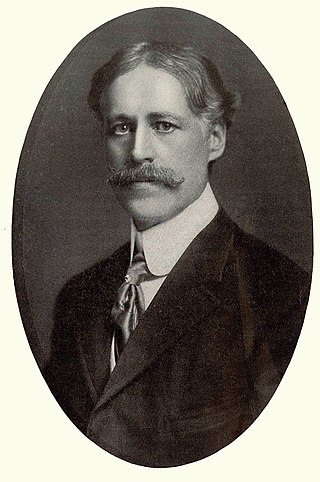
William Ordway Partridge was an American sculptor, teacher and author. Among his best-known works are the Shakespeare Monument in Chicago, the equestrian statue of General Grant in Brooklyn, the Pietà at St. Patrick's Cathedral in Manhattan, and the Pocahontas statue in Jamestown, Virginia.
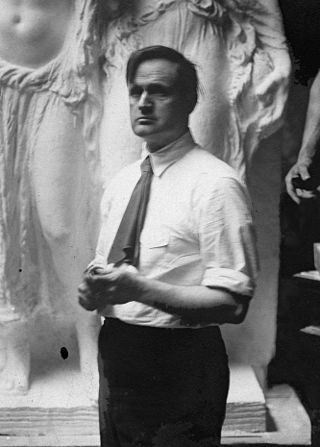
James Earle Fraser was an American sculptor during the first half of the 20th century. His work is integral to many of Washington, D.C.'s most iconic structures.
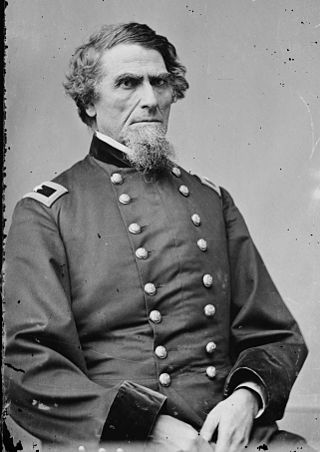
Benjamin Franklin Kelley was an American soldier who served as a brigadier general in the Union Army during the American Civil War. He played a prominent role in several military campaigns in West Virginia and Maryland.
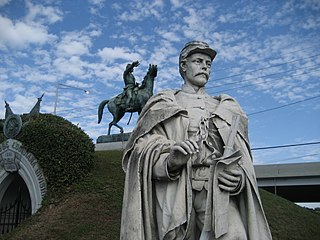
Alexander Doyle (1857–1922) was an American sculptor.

Save Outdoor Sculpture! (SOS!) was a community-based effort to identify, document, and conserve outdoor sculpture in the United States. The program was initiated in 1989 and ended in 1999.
The Hildebrand Monument is a public artwork fabricated by Joyce & Diener and located at Crown Hill National Cemetery in Indianapolis, Indiana. The monument marks the graves of Henry W. Hildebrand and his three children, William H., Louisa E., and George H. Hildebrand. It features an eighteen-foot column mounted on a rectangular base made of granite with a cornice that is peaked and a tiered bottom section. On top of the cornice is a full-sized statue of Henry W. Hildebrand wearing a frockcoat. In his left hand is an anchor and his right hand is upraised in the air. Behind him is a tree stump.

Colonel Emerson Hamilton Liscum was a U.S. Army officer who fought in the American Civil War, Indian Wars, Spanish–American War, and the Philippine–American War. He was killed in battle at Tianjin, China during the Boxer Rebellion while commanding the 9th Infantry Regiment.

Frederick Keep Monument is a public artwork by American artist James Earle Fraser, located at Rock Creek Cemetery in Washington, D.C., United States. "Frederick Keep Monument" was originally surveyed as part of the Smithsonian's Save Outdoor Sculpture! survey in 1993. This sculpture rests at the site of the grave of Frederick and Florence Keep and their child.

McKee Grave is a public artwork by an unknown artist, located at the Arlington National Cemetery, Arlington, Virginia, United States. It serves as the final resting place of First Lieutenant Thomas Hudson McKee and his wife.

Theodore Wint Grave is a public artwork by an unknown artist, located at the Arlington National Cemetery in Arlington, Virginia, United States. This sculpture was surveyed in 1995 as part of the Smithsonian's Save Outdoor Sculpture! program. "Theodore Wint Grave" serves as the final resting place for Brigadier General Theodore J. Wint.
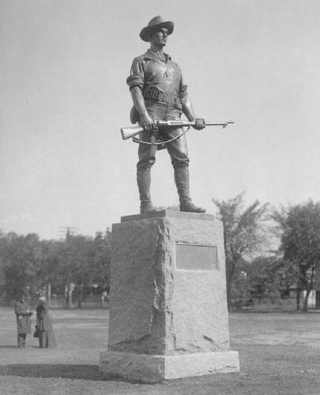
The Hiker is a statue created by Theo Alice Ruggles Kitson. It commemorates the American soldiers who fought in the Spanish–American War, the Boxer Rebellion and the Philippine–American War. The first version of it was made for the University of Minnesota in 1906, but at least 50 copies were made, and were erected widely across the United States.

William A. Starke Memorial is a public art work by American artist Robert Ingersoll Aitken, located in the Forest Home Cemetery on the south side of Milwaukee, Wisconsin. The artwork is a bronze figure depicting a seated angel. It is located in Section 33 of the cemetery at 2405 W. Forest Home Ave.

Theodore Roosevelt, Rough Rider is a toppled bronze sculpture, now officially de-accessioned, by American artist Alexander Phimister Proctor, located in the South Park Blocks of Portland, Oregon in the United States. The equestrian statue was completed in 1922 and depicts Theodore Roosevelt as the leader of the cavalry regiment that fought during the Spanish–American War called the Rough Riders.

The Three Graces, also known as Carytid Fountain Group, Friendship Fountain, The Three Bares, and Three Bares Fountain, is an outdoor fountain and sculpture by Gertrude Vanderbilt Whitney, installed in 1931 at Montreal's McGill University, in Quebec, Canada.

A statue of Alexander Hamilton by William Rimmer is installed along Commonwealth Avenue, between Arlington and Berkeley Streets, in Boston, Massachusetts, United States.

Boston Public Garden Flagpole Base is a 1921 flagpole base, memorial, and sculpture by William D. Austen, installed in Boston Public Garden, in Boston, Massachusetts, United States. The bronze base measures approximately 6 x 4 x 4 ft., and rests on a granite plinth that measures 3.5 x 7 x 7 ft. It has four facades with reliefs depicting American eagles holding branches and spreading their wings, and serves as a World War I memorial. The base replaced another destroyed by lightning in 1920. It was originally installed at the site of the original base, at the intersection of Boylston Street and Arlington Street, but was relocated to its present location in 1933. The work was surveyed by the Smithsonian Institution's "Save Outdoor Sculpture!" program in 1993.
















